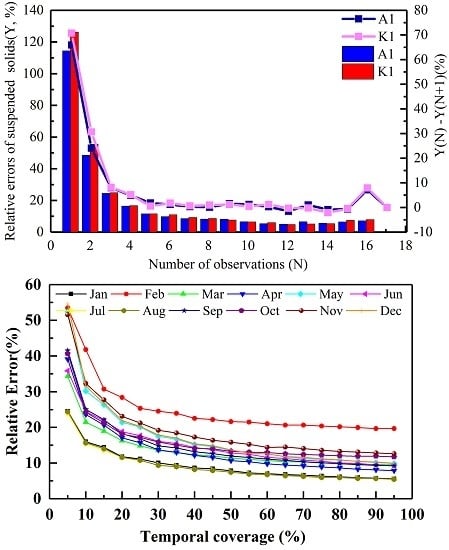Impacts of Insufficient Observations on the Monitoring of Short- and Long-Term Suspended Solids Variations in Highly Dynamic Waters, and Implications for an Optimal Observation Strategy
Abstract
:1. Introduction
2. Material and Methods
2.1. Study Area
2.2. Fixed Stations and Measurements
2.3. Remote Sensing Observations
2.4. Analysis Methods
3. Results
3.1. Variations of SS in Deep Bay
3.2. Errors Associated with Frequency of Observation for the SS Estimations
3.3. Errors Associated with Observation Times for the SS Estimations
4. Discussion
4.1. Estimating Errors of Satellite Remote Sensing
4.1.1. Daily Scale Observations
4.1.2. Monthly Scale Observations
4.1.3. Annual Scale Observations
4.2. Sensitivity of SS Monitoring with Satellite Coverage
5. Implications and Conclusions
Acknowledgements
Author Contributions
Conflicts of Interest
References
- Gleick, P.; White, F. Water in Crisis: A Guide to the World's Fresh Water Resources; Oxford University Press: New York, NY, USA, 1993. [Google Scholar]
- Bastviken, D.; Tranvik, L.J.; Downing, J.A.; Crill, P.M.; Enrich-Prast, A. Freshwater methane emissions offset the continental carbon sink. Sciences 2011, 331, 50–55. [Google Scholar] [CrossRef] [PubMed]
- Allan, J.D.; McIntyre, P.B.; Smith, S.D.P.; Halpern, B.S.; Boyer, G.L.; Buchsbaum, A.; Burton, G.A.; Campbell, L.M.; Chadderton, W.L.; Ciborowski, J.J.H.; et al. Joint analysis of stressors and ecosystem services to enhance restoration effectiveness. Proc. Natl. Acad. Sci. USA 2013, 110, 372–377. [Google Scholar] [CrossRef] [PubMed]
- Heath, M.R. Comment on “a global map of human impact on marine ecosystems”. Sciences 2008, 321, 948–952. [Google Scholar] [CrossRef] [PubMed] [Green Version]
- Torbick, N.; Hession, S.; Hagen, S.; Wiangwang, N.; Becker, B.; Qi, J. Mapping inland lake water quality across the lower peninsula of michigan using landsat tm imagery. Int. J. Remote Sens. 2013, 34, 7607–7624. [Google Scholar] [CrossRef]
- Dudgeon, D.; Arthington, A.H.; Gessner, M.O.; Kawabata, Z.; Knowler, D.J.; Lévêque, C.; Naiman, R.J.; Prieur-Richard, A.H.; Soto, D.; Stiassny, M.L. Freshwater biodiversity: Importance, threats, status and conservation challenges. Biol. Rev. Camb. Philos. Soc. 2006, 81, 163–182. [Google Scholar] [CrossRef] [PubMed]
- O’Shea, M.L.; Brosnan, T.M. Trends in indicators of eutrophication in western long island sound and the hudson-raritan estuary. Estuaries Coasts 2000, 23, 877. [Google Scholar] [CrossRef]
- Paerl, H.W.; Valdes, L.M.; Piehler, M.F.; Stow, C.A. Assessing the effects of nutrient management in an estuary experiencing climatic change: The neuse river estuary, north carolina. Environ. Manag. 2006, 37, 422–436. [Google Scholar] [CrossRef] [PubMed]
- Glasgow, H.B.; Burkholder, J.A.M.; Reed, R.E.; Lewitus, A.J.; Kleinman, J.E. Real-time remote monitoring of water quality: A review of current applications, and advancements in sensor, telemetry, and computing technologies. J. Exp. Mar. Biol. Ecol. 2004, 300, 409–448. [Google Scholar] [CrossRef]
- Zolfaghari, K.; Duguay, C. Estimation of water quality parameters in lake erie from meris using linear mixed effect models. Remote Sens. 2016, 8, 473. [Google Scholar] [CrossRef]
- Joshi, I.D.; D’Sa, E.J.; Osburn, C.L.; Bianchi, T.S.; Dong, S.K.; Oviedo-Vargas, D.; Arellano, A.R.; Ward, N.D. Assessing chromophoric dissolved organic matter (cdom) distribution, stocks, and fluxes in apalachicola bay using combined field, viirs ocean color, and model observations. Remote Sens. Environ. 2017, 191, 359–372. [Google Scholar] [CrossRef]
- Ritchie, J.C.; Zimba, P.V.; Everitt, J.H. Remote sensing techniques to assess water quality. Photogramm. Eng. Remote Sens. 2003, 69, 695–704. [Google Scholar] [CrossRef]
- Wang, Y.; Xia, H.; Fu, J.; Sheng, G. Water quality change in reservoirs of shenzhen, china: Detection using landsat/tm data. Sci. Total Environ. 2004, 328, 195. [Google Scholar] [CrossRef] [PubMed]
- Mouw, C.B.; Greb, S.; Aurin, D.; DiGiacomo, P.M.; Lee, Z.; Twardowski, M.; Binding, C.; Hu, C.; Ma, R.; Moore, T.; et al. Aquatic color radiometry remote sensing of coastal and inland waters: Challenges and recommendations for future satellite missions. Remote Sens. Environ. 2015, 160, 15–30. [Google Scholar] [CrossRef]
- Feng, L.; Hu, C.; Chen, X.; Cai, X.; Tian, L.; Gan, W. Assessment of inundation changes of poyang lake using modis observations between 2000 and 2010. Remote Sens. Environ. 2012, 121, 80–92. [Google Scholar] [CrossRef]
- Matthews, M.W.; Bernard, S.; Robertson, L. An algorithm for detecting trophic status (chlorophyll-a), cyanobacterial-dominance, surface scums and floating vegetation in inland and coastal waters. Remote Sens. Environ. 2012, 124, 637–652. [Google Scholar] [CrossRef]
- Mcclain, C.R.; Meister, G. Mission Requirements for Future Ocean-Colour Sensors; International Ocean-Colour Coordinating Group (IOCCG) Report Series, No. 13; IOCCG: Dartmouth, NS, Canada, 2012. [Google Scholar]
- Hu, C.; Feng, L.; Lee, Z.; Davis, C.O.; Mannino, A.; Mcclain, C.R.; Franz, B.A. Dynamic range and sensitivity requirements of satellite ocean color sensors: Learning from the past. Appl. Opt. 2012, 51, 6045. [Google Scholar] [CrossRef] [PubMed]
- Maritorena, S.; D’Andon, O.H.F.; Mangin, A.; Siegel, D.A. Merged satellite ocean color data products using a bio-optical model: Characteristics, benefits and issues. Remote Sens. Environ. 2010, 114, 1791–1804. [Google Scholar] [CrossRef]
- Choi, J.-K.; Park, Y.J.; Ahn, J.H.; Lim, H.-S.; Eom, J.; Ryu, J.-H. Goci, the world’s first geostationary ocean color observation satellite, for the monitoring of temporal variability in coastal water turbidity. J. Geophys. Res. Oceans 2012, 117, 4–9. [Google Scholar] [CrossRef]
- Ody, A.; Doxaran, D.; Vanhellemont, Q.; Nechad, B.; Novoa, S.; Many, G.; Bourrin, F.; Verney, R.; Pairaud, I.; Gentili, B. Potential of high spatial and temporal ocean color satellite data to study the dynamics of suspended particles in a micro-tidal river plume. Remote Sens. 2016, 8, 245. [Google Scholar] [CrossRef] [Green Version]
- Kaufman, Y.J.; Remer, L.A.; Tanre, D.; Li, R.R.; Kleidman, R.; Mattoo, S.; Levy, R.C.; Eck, T.F.; Holben, B.N.; Ichoku, C. A critical examination of the residual cloud contamination and diurnal sampling effects on modis estimates of aerosol over ocean. IEEE Trans. Geosci. Remote Sens. 2005, 43, 2886–2897. [Google Scholar] [CrossRef]
- Racault, M.F.; Sathyendranath, S.; Platt, T. Impact of missing data on the estimation of ecological indicators from satellite ocean-colour time-series. Remote Sens. Environ. 2014, 152, 15–28. [Google Scholar] [CrossRef]
- Goyens, C.; Jamet, C.; Schroeder, T. Evaluation of four atmospheric correction algorithms for modis-aqua images over contrasted coastal waters. Remote Sens. Environ. 2013, 131, 63–75. [Google Scholar] [CrossRef]
- Antoine, D. Ocean-Colour Observations from a Geostationary Orbit; International Ocean-Colour Coordinating Group (IOCCG) Report Series, No. 12; IOCCG: Dartmouth, NS, Canada, 2012. [Google Scholar]
- Gregg, W.W.; Casey, N.W. Sampling biases in modis and seawifs ocean chlorophyll data. Remote Sens. Environ. 2007, 111, 25–35. [Google Scholar] [CrossRef]
- Chen, Z.; Hu, C.; Muller-Karger, F.E.; Luther, M.E. Short-term variability of suspended sediment and phytoplankton in tampa bay, florida: Observations from a coastal oceanographic tower and ocean color satellites. Estuar. Coast. Shelf Sci. 2010, 89, 62–72. [Google Scholar] [CrossRef]
- Garaba, S.P.; Badewien, T.H.; Braun, A.; Schulz, A.C.; Zielinski, O. Using ocean colour remote sensing products to estimate turbidity at the wadden sea time series station spiekeroog. J. Eur. Opt. Soc. 2014, 9, 1–6. [Google Scholar] [CrossRef]
- Zhou, Z.; Bian, C.; Wang, C.; Jiang, W.; Bi, R. Quantitative assessment on multiple timescale features and dynamics of sea surface suspended sediment concentration using remote sensing data. J. Geophys. Res. Oceans 2017, 122, 8739–8752. [Google Scholar] [CrossRef]
- Reuter, R.; Badewien, T.H.; Bartholomä, A.; Braun, A.; Lübben, A.; Rullkötter, J. A hydrographic time series station in the wadden sea (southern north sea). Ocean Dyn. 2009, 59, 195–211. [Google Scholar] [CrossRef]
- Tian, L.; Wai, O.; Chen, X.; Liu, Y.; Feng, L.; Li, J.; Huang, J. Assessment of total suspended sediment distribution under varying tidal conditions in deep bay: Initial results from hj-1a/1b satellite ccd images. Remote Sens. 2014, 6, 9911–9929. [Google Scholar] [CrossRef]
- Hun, J.; Wei, L.; Qian, A. Three-Dimensional Modeling of Hydrodynamic and Flushing in Deep Bay. In Proceedings of the International Conference on Estuaries & Coasts, Hangzhou, China, 9–11 November 2003; pp. 9–11. [Google Scholar]
- Smith, V.H.; Joye, S.B.; Howarth, R.W. Eutrophication of freshwater and marine ecosystems. Limnol. Oceanogr. 2006, 51, 351–355. [Google Scholar] [CrossRef]
- Jie, X.; Yin, K.D.; Lee, J.H.W.; Liu, H.B.; Ho, A.Y.T.; Yuan, X.C.; Harrison, P.J.; Zingone, A.; Phlips, E.J.; Harrison, P.J. Long-term and seasonal changes in nutrients, phytoplankton biomass, and dissolved oxygen in deep bay, hong kong. Estuaries Coasts 2010, 33, 399–416. [Google Scholar]
- Downing, J. Twenty-five years with obs sensors: The good, the bad, and the ugly. Cont. Shelf Res. 2006, 26, 2299–2318. [Google Scholar] [CrossRef]
- Le, C.F.; Li, Y.M.; Yong, Z.; Sun, D.Y.; Yin, B. Validation of a quasi-analytical algorithm for highly turbid eutrophic water of meiliang bay in taihu lake, china. IEEE Trans. Geosci. Remote Sens. 2009, 47, 2492–2500. [Google Scholar]
- Jian, Q.; Liang, B.; Wang, T.; Chen, J.; Zhang, H. Research on online-monitoring method and practice of obs-3a. J. Changjiang Eng. Vocat. Coll. 2008, 25, 28–31. [Google Scholar]
- Chang, L.; Peng, Y.; Huang, H. Application of new instruments and equipments in shenzhen river hydrological measurement. J. Changjiang Eng. Vocat. Coll. 2012, 29, 23–24. [Google Scholar]
- Tian, L.; Wai, O.W.H.; Chen, X.; Li, W.; Li, J.; Li, W.; Zhang, H. Retrieval of total suspended matter concentration from gaofen-1 wide field imager wfi multispectral imagery with the assistance of terra modis in turbid water—Case in deep bay. Int. J. Remote Sens. 2016, 37, 3400–3413. [Google Scholar] [CrossRef]
- Miller, R.L.; McKee, B.A. Using modis terra 250 m imagery to map concentrations of total suspended matter in coastal waters. Remote Sens. Environ. 2004, 93, 259–266. [Google Scholar] [CrossRef]
- Wu, G.; Cui, L.; He, J.; Duan, H.; Fei, T.; Liu, Y. Comparison of modis-based models for retrieving suspended particulate matter concentrations in poyang lake, china. Int. J. Appl. Earth Obs. Geoinf. 2013, 24, 63–72. [Google Scholar] [CrossRef]
- Doxaran, D.; Lamquin, N.; Park, Y.J.; Mazeran, C.; Ryu, J.H.; Wang, M.; Poteau, A. Retrieval of the seawater reflectance for suspended solids monitoring in the east china sea using modis, meris and goci satellite data. Remote Sens. Environ. 2014, 146, 36–48. [Google Scholar] [CrossRef]
- Wang, W.; Jiang, W. Study on the seasonal variation of the suspended sediment distribution and transportation in the east china seas based on seawifs data. J. Ocean Univ. China 2008, 7, 385–392. [Google Scholar] [CrossRef]
- Nechad, B.; Ruddick, K.G.; Park, Y. Calibration and validation of a generic multisensor algorithm for mapping of total suspended matter in turbid waters. Remote Sens. Environ. 2010, 114, 854–866. [Google Scholar] [CrossRef]
- Sun, D.; Li, Y.; Le, C.; Shi, K.; Huang, C.; Gong, S.; Yin, B. A semi-analytical approach for detecting suspended particulate composition in complex turbid inland waters (china). Remote Sens. Environ. 2013, 134, 92–99. [Google Scholar] [CrossRef]
- Wang, J.J.; Lu, X.X. Estimation of suspended sediment concentrations using terra modis: An example from the lower yangtze river, china. Sci. Total Environ. 2010, 408, 1131–1138. [Google Scholar] [CrossRef] [PubMed]
- Tarrant, P.E.; Amacher, J.A.; Neuer, S. Assessing the potential of medium-resolution imaging spectrometer (meris) and moderate-resolution imaging spectroradiometer (modis) data for monitoring total suspended matter in small and intermediate sized lakes and reservoirs. Water Resour. Res. 2010, 46, 2973–2976. [Google Scholar] [CrossRef]
- IOCCG. Remote Sensing of Ocean Colour in Coastal, and Other Optically-Complex, Waters; IOCCG: Dartmouth, NS, Canada, 2000. [Google Scholar]
- Schrage, L. Optimization Modeling with Lingo; Lindo System: Chicago, IL, USA, 2006. [Google Scholar]
- Zibordi, G.; Mélin, F.; Berthon, J.F.; Canuti, E. Assessment of meris ocean color data products for european seas. Ocean Sci. 2013, 9, 521–533. [Google Scholar] [CrossRef]
- Zhao, W.J.; Wang, G.Q. Assessment of seawifs, modis, and meris ocean colour products in the south china sea. Int. J. Remote Sens. 2014, 35, 4252–4274. [Google Scholar] [CrossRef]
- Feng, L.; Hu, C.; Chen, X.; Song, Q. Influence of the three gorges dam on total suspended matters in the yangtze estuary and its adjacent coastal waters: Observations from modis. Remote Sens. Environ. 2014, 140, 779–788. [Google Scholar] [CrossRef]
- Petus, C.; Marieu, V.; Novoa, S.; Chust, G.; Bruneau, N.; Froidefond, J.M. Monitoring spatio-temporal variability of the adour river turbid plume (bay of biscay, france) with modis 250-m imagery. Cont. Shelf Res. 2014, 74, 35–49. [Google Scholar] [CrossRef] [Green Version]
- Ruddick, K.; Neukermans, G.; Vanhellemont, Q.; Jolivet, D. Challenges and opportunities for geostationary ocean colour remote sensing of regional seas: A review of recent results. Remote Sens. Environ. 2014, 146, 63–76. [Google Scholar] [CrossRef]
- Philipson, P.; Kratzer, S.; Ben Mustapha, S.; Strömbeck, N.; Stelzer, K. Satellite-based water quality monitoring in lake vänern, sweden. Int. J. Remote Sens. 2016, 37, 3938–3960. [Google Scholar] [CrossRef]
- Feng, L.; Hu, C. Comparison of valid ocean observations between modis terra and aqua over the global oceans. IEEE Trans. Geosci. Remote Sens. 2016, 54, 1575–1585. [Google Scholar] [CrossRef]
- Gregg, W.W.; Esaias, W.E.; Feldman, G.C.; Frouin, R.; Hooker, S.B.; Mcclain, C.R.; Woodward, R.H. Coverage opportunities for global ocean color in a multimission era. IEEE Trans. Geosci. Remote Sens. 1998, 36, 1620–1627. [Google Scholar] [CrossRef]
- Barnes, B.B.; Hu, C. Cross-sensor continuity of satellite-derived water clarity in the gulf of mexico: Insights into temporal aliasing and implications for long-term water clarity assessment. IEEE Trans. Geosci. Remote Sens. 2014, 53, 1761–1772. [Google Scholar] [CrossRef]
- Palmer, S.C.J.; Kutser, T.; Hunter, P.D. Remote sensing of inland waters: Challenges, progress and future directions. Remote Sens. Environ. 2015, 157, 1–8. [Google Scholar] [CrossRef]

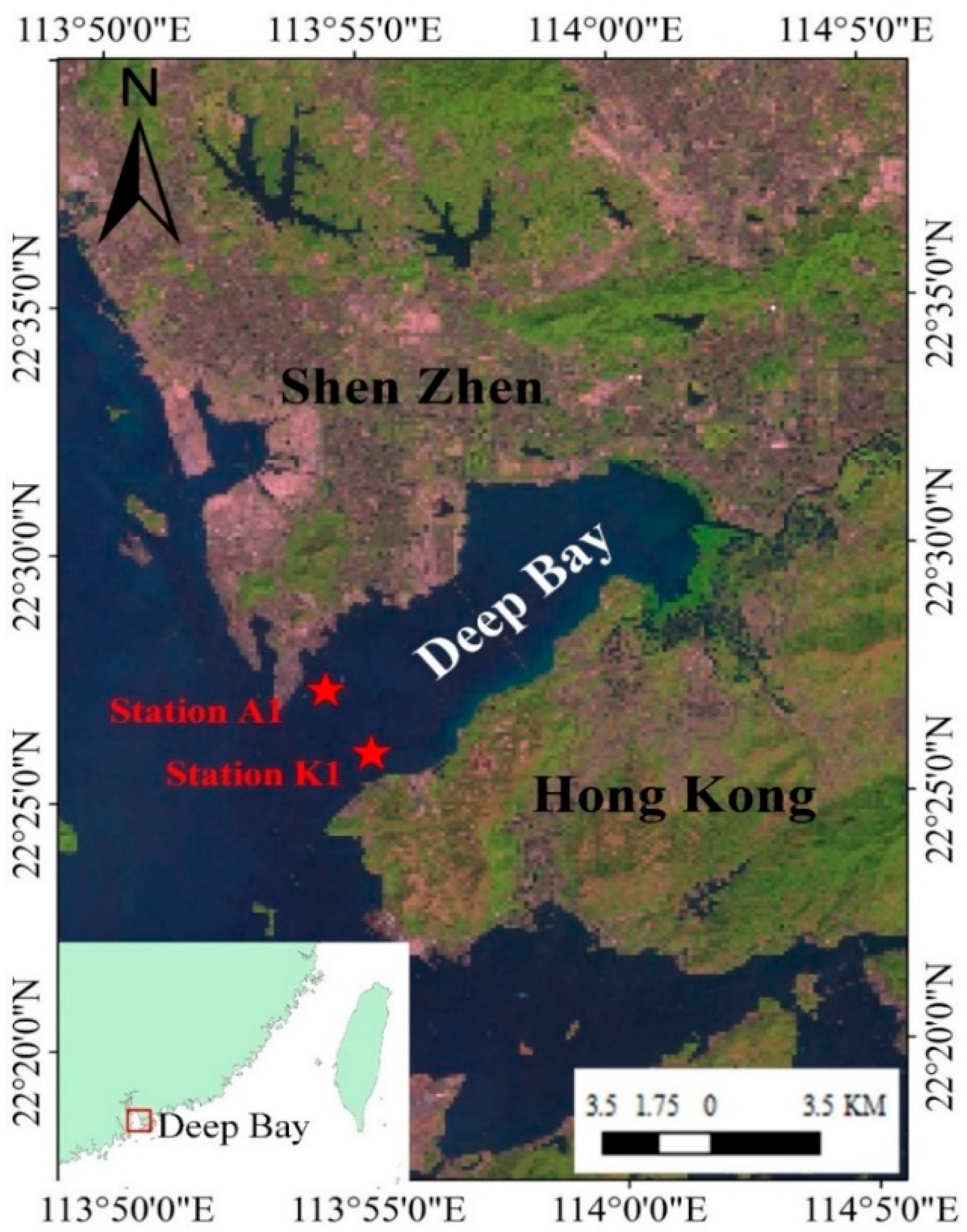
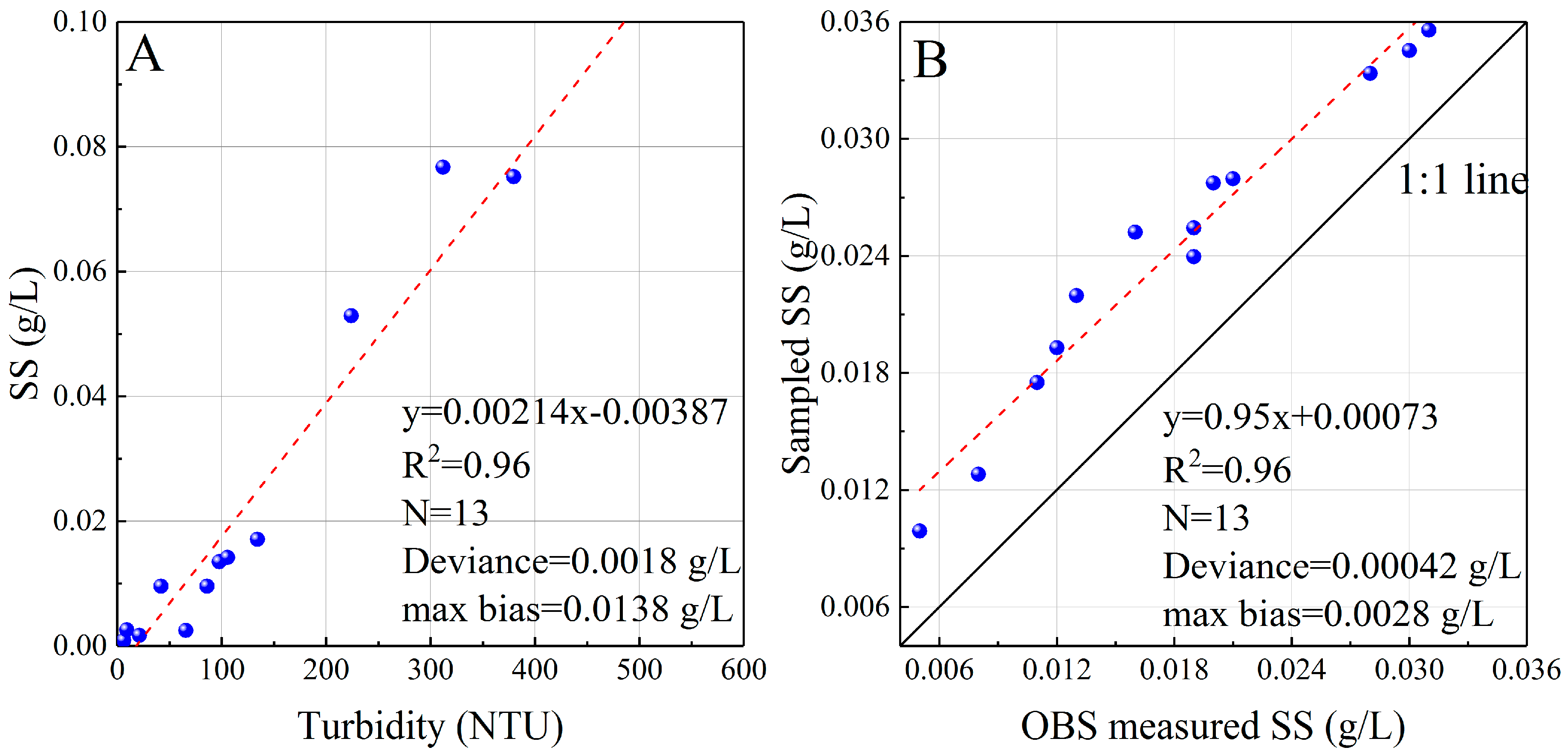
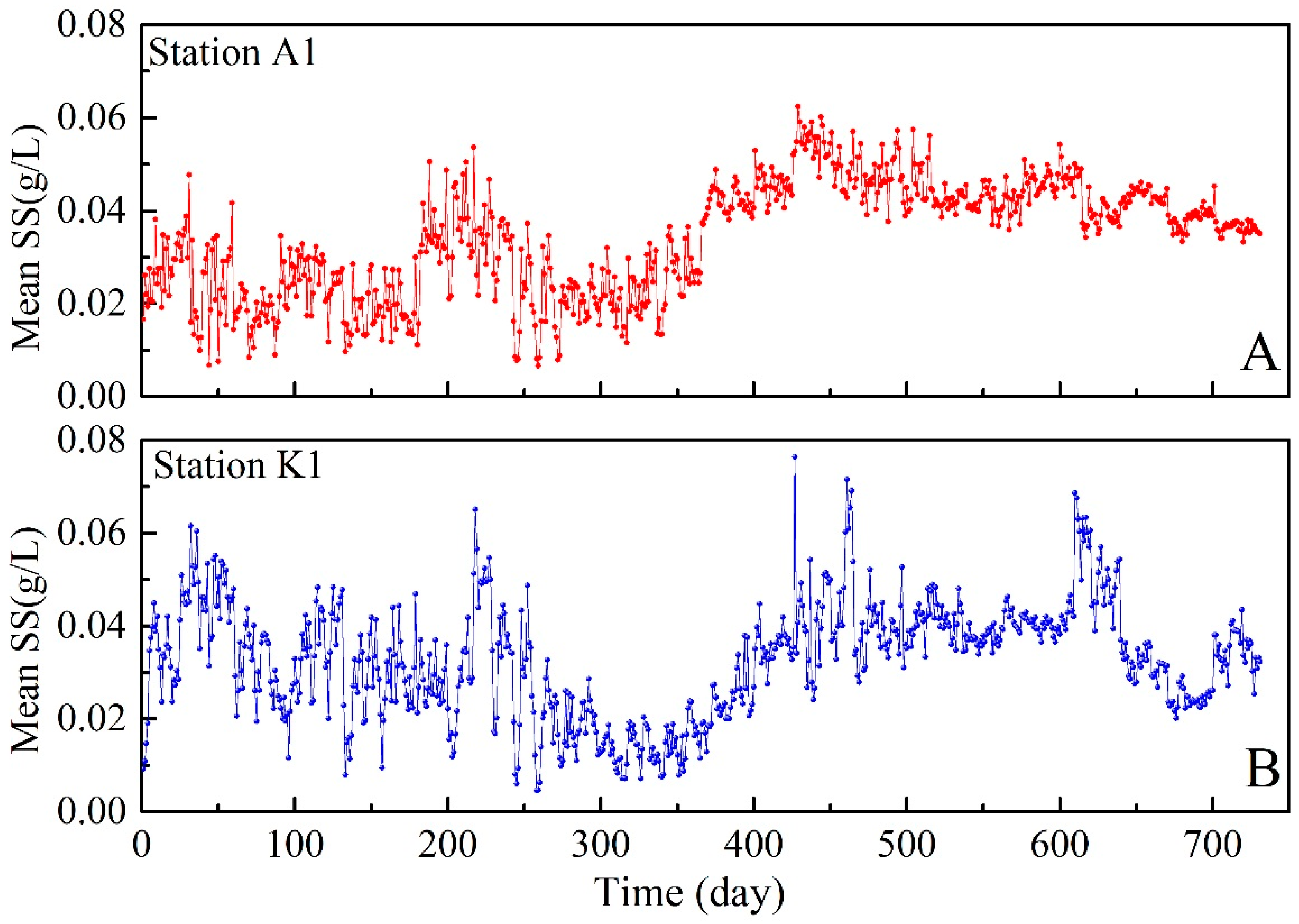
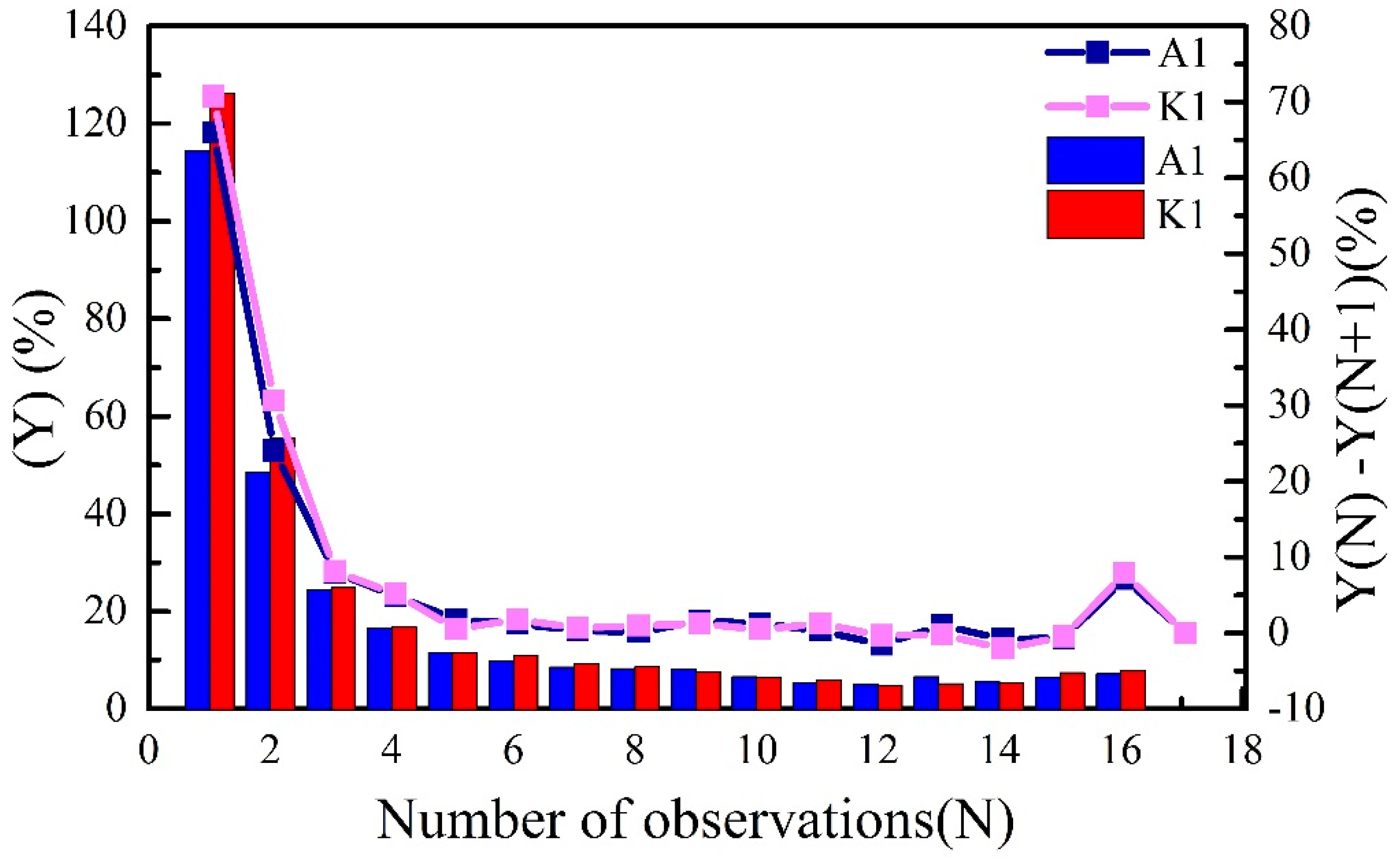
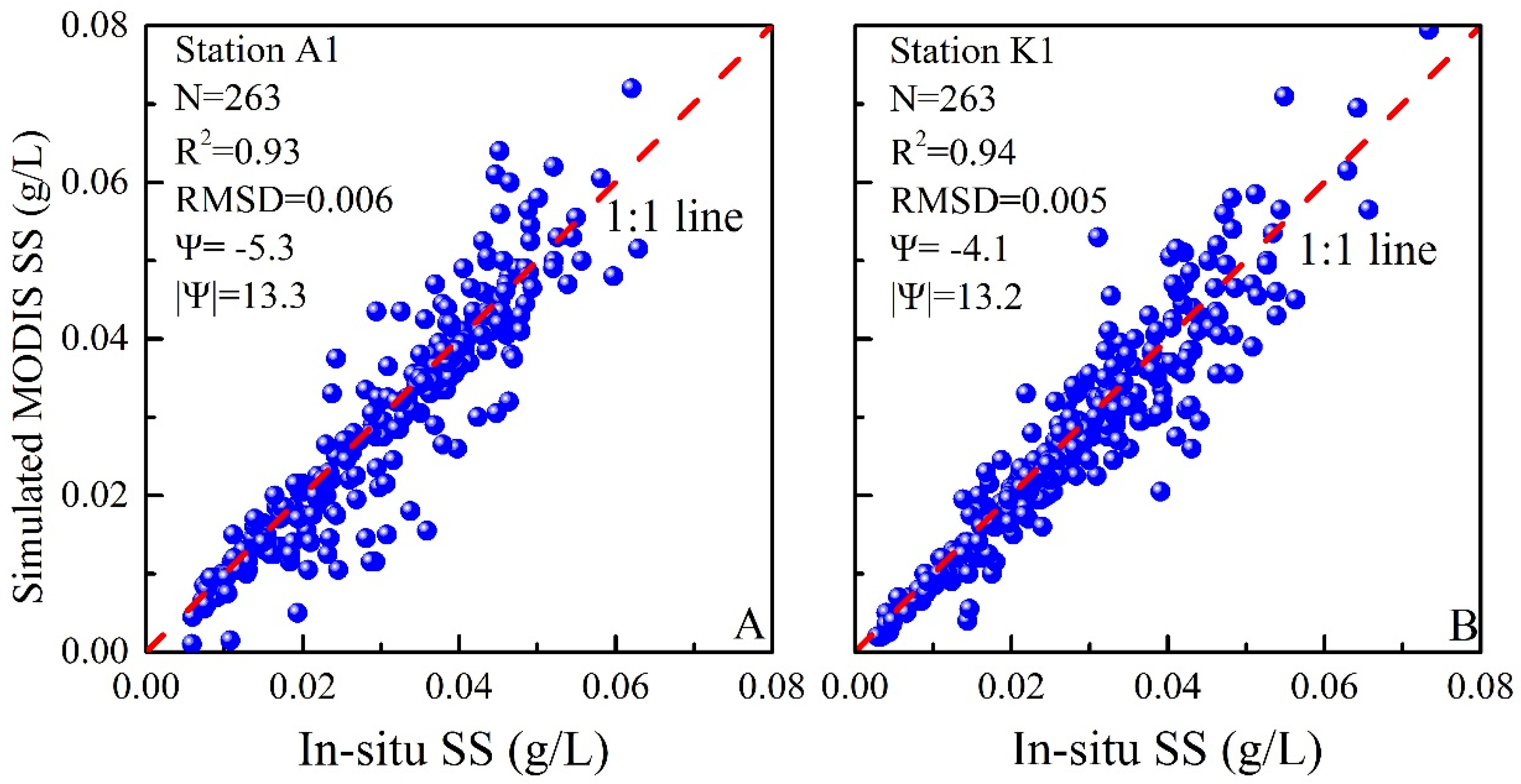
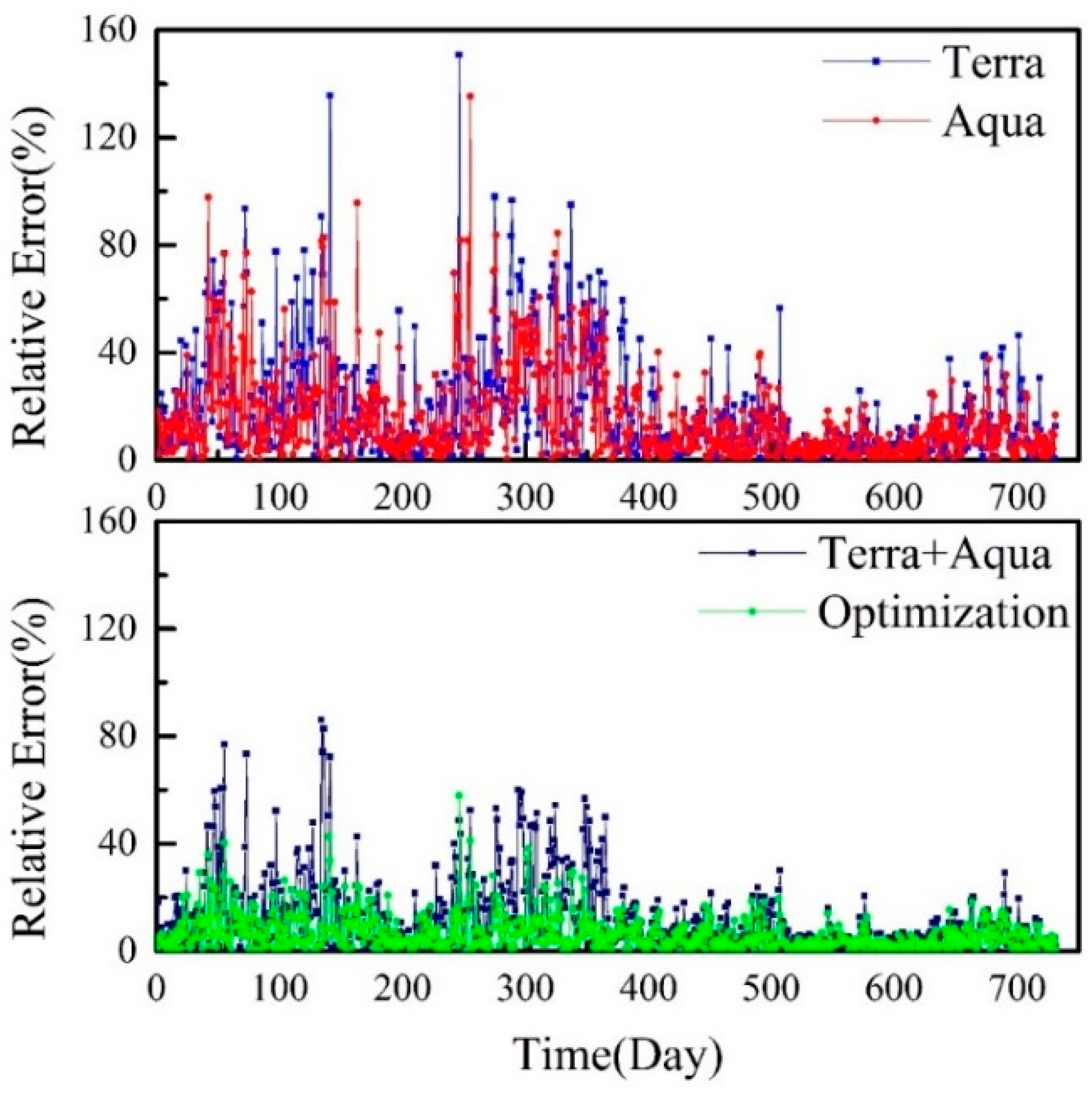
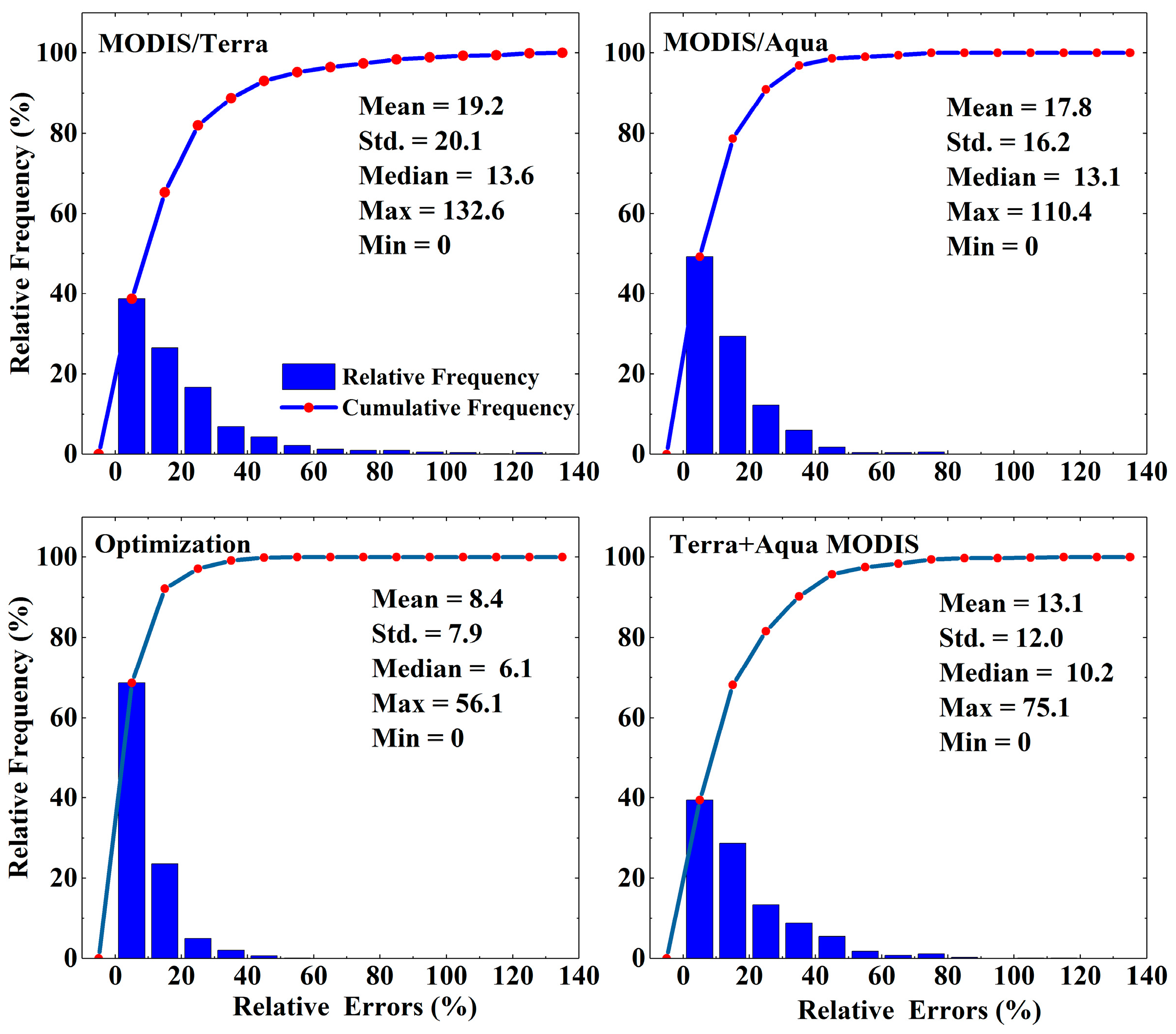
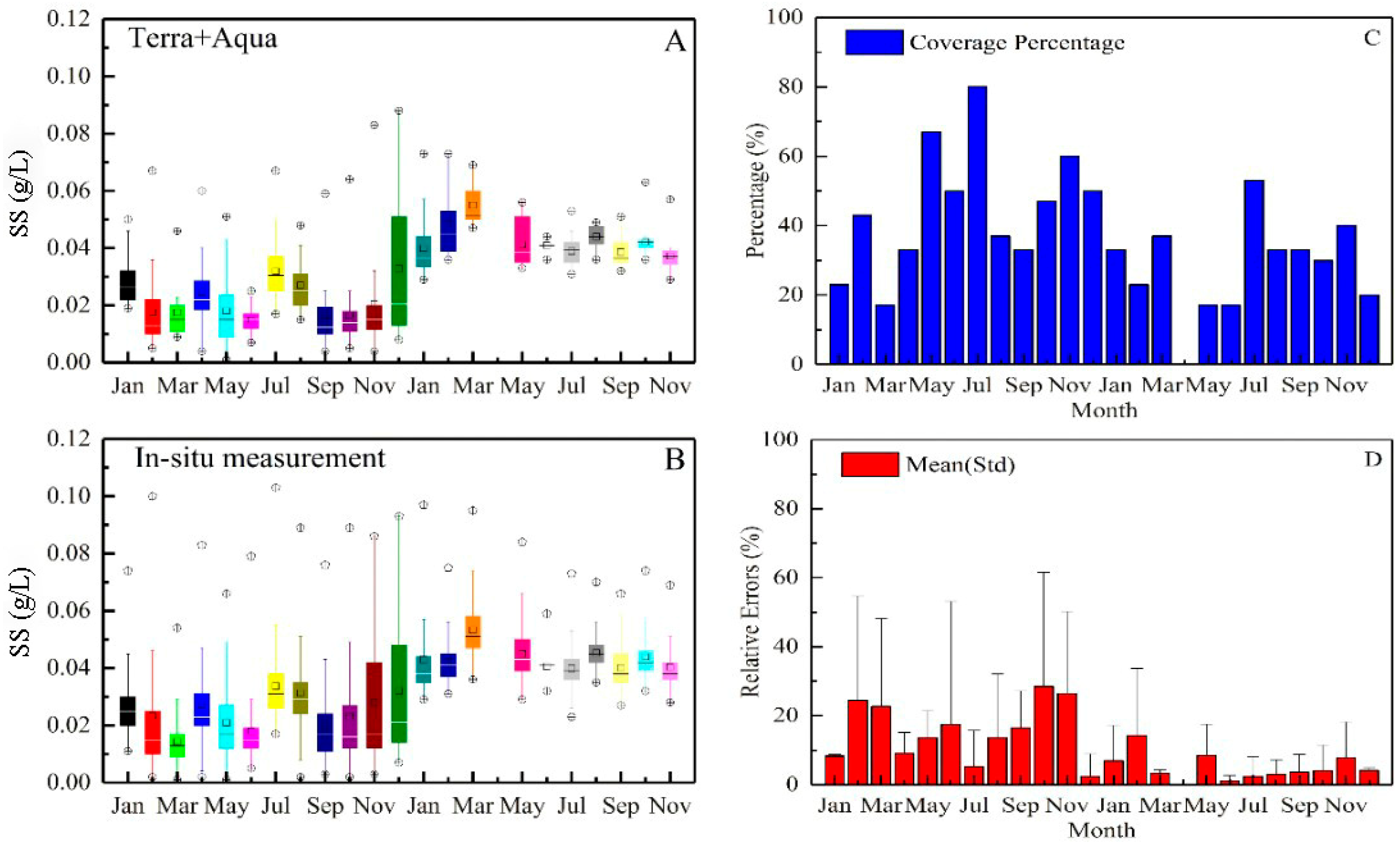
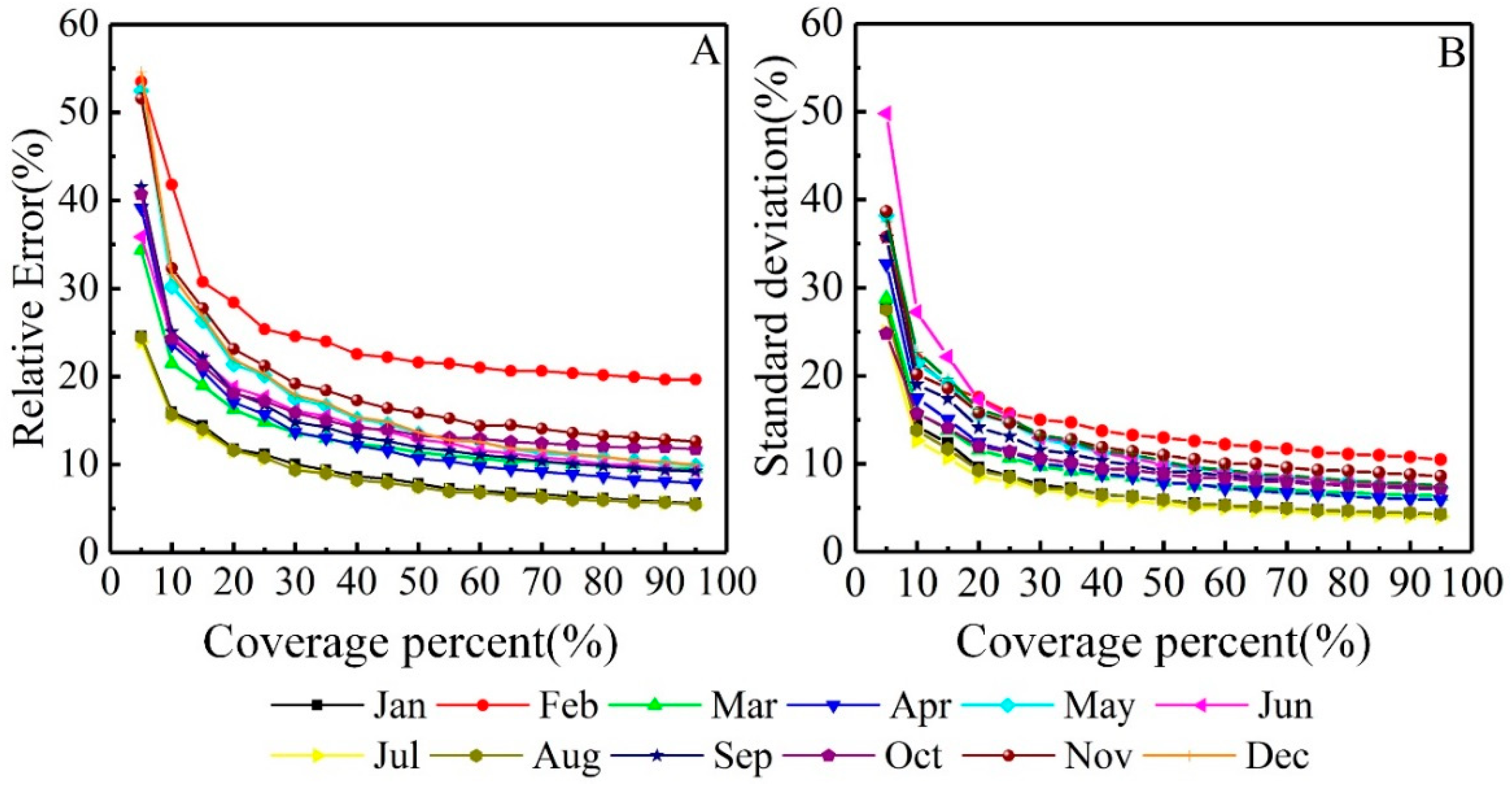
| Station | Date | Regression Model (y: SS; x: Turbidity) | Station | Date | Regression Model (y: SS; x: Turbidity) |
|---|---|---|---|---|---|
| A1 | 2007/1/5 | y = 0.00097x − 0.00138 | K1 | 2007/1/5 | y = 0.00100x − 0.00027 |
| 2007/2/3 | y = 0.00136x − 0.01892 | 2007/3/1 | y = 0.00119x − 0.00056 | ||
| 2007/3/2 | y = 0.00214x − 0.00387 | 2007/3/18 | y = 0.00118x + 0.00306 | ||
| 2007/3/16 | y = 0.00090x − 0.00489 | 2007/4/4 | y = 0.00115x + 0.00147 | ||
| 2007/4/5 | y = 0.00098x − 0.00264 | 2007/5/5 | y = 0.00126x − 0.00517 | ||
| 2007/4/22 | y = 0.00097x − 0.00330 | 2007/5/16 | y = 0.00125x − 0.00154 | ||
| 2007/5/15 | y = 0.00095x − 0.00979 | 2007/6/5 | y = 0.00170x − 0.00667 | ||
| 2007/6/1 | y = 0.00100x − 0.00717 | 2007/7/1 | y = 0.00125x − 0.00212 | ||
| 2007/7/3 | y = 0.00116x + 0.00645 | 2007/7/23 | y = 0.00125x − 0.00009 | ||
| 2007/7/19 | y = 0.00096x + 0.00705 | 2007/8/16 | y = 0.00154x + 0.00716 | ||
| 2007/7/23 | y = 0.00116x + 0.00645 | 2007/8/30 | y = 0.00114x + 0.00625 | ||
| 2007/8/18 | y = 0.00127x − 0.00527 | 2007/9/5 | y = 0.00150x − 0.00463 | ||
| 2007/9/2 | y = 0.00098x − 0.00304 | 2007/10/20 | y = 0.00111x − 0.00522 | ||
| 2007/10/26 | y = 0.00141x − 0.00883 | 2007/11/6 | y = 0.00112x − 0.00821 | ||
| 2007/11/6 | y = 0.00135x − 0.00731 | 2007/12/23 | y = 0.00114x − 0.00844 | ||
| 2007/12/11 | y = 0.00139x − 0.00674 | 2008/1/27 | y = 0.00129x + −0.00042 | ||
| 2008/1/27 | y = 0.00137x + 0.00904 | 2008/2/17 | y = 0.00134x + 0.00101 | ||
| 2008/2/25 | y = 0.00096x + 0.01595 | 2008/3/27 | y = 0.00144x + 0.00085 | ||
| 2008/3/18 | y = 0.00085x + 0.02874 | 2008/4/26 | y = 0.00124x + 0.00525 | ||
| 2008/4/28 | y = 0.00094x + 0.01963 | 2008/7/28 | y = 0.00193x + 0.00353 | ||
| 2008/7/26 | y = 0.00191x − −0.0008 | 2008/8/21 | y = 0.00158x + 0.00844 | ||
| 2008/8/23 | y = 0.00137x + 0.01417 | 2008/9/25 | y = 0.00182x + −0.00392 | ||
| 2008/9/24 | y = 0.00166x + 0.01285 | 2008/10/18 | y = 0.00116x + −0.00341 | ||
| 2008/10/28 | y = 0.00162x + 0.01586 | 2008/11/27 | y = 0.00109x + −0.00220 | ||
| 2008/11/28 | y = 0.00159x + 0.00972 | 2008/12/24 | y = 0.00128x + 0.00475 | ||
| 2008/12/18 | y = 0.00117x + 0.01507 | ||||
| Jan | Feb | Mar | Apr | May | Jun | Jul | Aug | Sep | Oct | Nov | Dec | Total | |
|---|---|---|---|---|---|---|---|---|---|---|---|---|---|
| 2007 | 7 | 13 | 5 | 10 | 20 | 15 | 24 | 11 | 10 | 14 | 18 | 15 | 162 |
| Coverage | 23% | 43% | 17% | 33% | 67% | 50% | 80% | 37% | 33% | 47% | 60% | 50% | 45% |
| 2008 | 10 | 7 | 11 | 0 | 5 | 5 | 16 | 10 | 10 | 9 | 12 | 6 | 101 |
| Coverage | 33% | 23% | 37% | 0% | 17% | 17% | 53% | 33% | 33% | 30% | 40% | 20% | 28% |
| Station | Mean SS (g/L) | Max SS (g/L) | Min SS (g/L) | STD (g/L) | SDC (%) |
|---|---|---|---|---|---|
| A1 | 0.0341 | 0.1180 | <10−4 | 0.0167 | 48.94 |
| A1 (2007) | 0.0244 | 0.1180 | <10−4 | 0.0165 | 67.59 |
| A1 (2008) | 0.0437 | 0.1090 | 0.0230 | 0.0100 | 22.94 |
| K1 | 0.0327 | 0.1290 | <10−4 | 0.0177 | 54.07 |
| K1 (2007) | 0.0281 | 0.1060 | <10−4 | 0.0174 | 62.00 |
| K1 (2008) | 0.0373 | 0.1290 | 0.0080 | 0.0167 | 44.83 |
| N | Site A1 | Site K1 | ||
|---|---|---|---|---|
| Observation Time | RE | Observation Time | RE | |
| 1 | 14:00 | 114.5% | 13:00 | 126.3% |
| 2 | 11:00, 15:30 | 48.6% | 11:00, 16:00 | 55.6% |
| 3 | 10:00, 13:00, 16:00 | 24.5% | 10:00, 13:00, 16:00 | 24.5% |
| 4 | 10:00, 12:00, 14:00, 16:30 | 16.5% | 9:30, 12:00, 14:00, 16:00 | 16.7% |
| 5 | 9:30, 11:30, 13:00, 14:30, 16:30 | 11.6% | 9:30, 11:30, 13:00, 14:30, 16:30 | 11.5% |
| Max SS (g/L) | Min SS (g/L) | Coverage | |||||
|---|---|---|---|---|---|---|---|
| In-Situ | Satellite | RE | In-Situ | Satellite | RE | ||
| Jan | 0.074 | 0.050 | 32.4% | 0.014 | 0.019 | 35.7% | 28.0% |
| Feb | 0.100 | 0.067 | 33.0% | 0.005 | 0.005 | 0.0% | 33.0% |
| Mar | 0.046 | 0.041 | 12.2% | 0.005 | 0.009 | 80.0% | 27.0% |
| Apr | 0.060 | 0.057 | 5.3% | 0.004 | 0.012 | 66.7% | 16.5% |
| May | 0.051 | 0.048 | 6.2% | 0.001 | 0.002 | 50.0% | 42.0% |
| Jun | 0.062 | 0.025 | 59.7% | 0.006 | 0.007 | 16.7% | 33.5% |
| Jul | 0.098 | 0.067 | 31.6% | 0.017 | 0.018 | 5.6% | 66.5% |
| Aug | 0.085 | 0.048 | 43.5% | 0.015 | 0.016 | 6.3% | 35.0% |
| Sep | 0.059 | 0.047 | 25.5% | 0.004 | 0.010 | 60.0% | 33.0% |
| Oct | 0.085 | 0.064 | 24.7% | 0.005 | 0.006 | 16.7% | 38.5% |
| Nov | 0.068 | 0.061 | 10.3% | 0.004 | 0.008 | 50.0% | 50.0% |
| Dec | 0.059 | 0.05 | 15.3% | 0.031 | 0.033 | 6.1% | 35.0% |
| Ave | - | - | 25.9% | - | - | 35.2% | 36.5% |
| Annual Mean SS (g/L) | Relative Errors (%) | |||||
|---|---|---|---|---|---|---|
| Site | Year | MODIS\ Aqua | MODIS\ Terra | In-Situ Measurements | MODIS\ Aqua | MODIS\ Terra |
| A1 | 2007 | 0.027 | 0.023 | 0.025 | 8.95 | 8.28 |
| 2008 | 0.042 | 0.042 | 0.043 | 1.90 | 1.52 | |
| 2007&2008 | 0.034 | 0.030 | 0.034 | 1.19 | 10.71 | |
| K1 | 2007 | 0.022 | 0.026 | 0.027 | 18.05 | 4.08 |
| 2008 | 0.031 | 0.033 | 0.036 | 13.10 | 5.92 | |
| 2007&2008 | 0.026 | 0.029 | 0.031 | 15.78 | 7.93 | |
© 2018 by the authors. Licensee MDPI, Basel, Switzerland. This article is an open access article distributed under the terms and conditions of the Creative Commons Attribution (CC BY) license (http://creativecommons.org/licenses/by/4.0/).
Share and Cite
Zhou, Q.; Tian, L.; Wai, O.W.H.; Li, J.; Sun, Z.; Li, W. Impacts of Insufficient Observations on the Monitoring of Short- and Long-Term Suspended Solids Variations in Highly Dynamic Waters, and Implications for an Optimal Observation Strategy. Remote Sens. 2018, 10, 345. https://doi.org/10.3390/rs10020345
Zhou Q, Tian L, Wai OWH, Li J, Sun Z, Li W. Impacts of Insufficient Observations on the Monitoring of Short- and Long-Term Suspended Solids Variations in Highly Dynamic Waters, and Implications for an Optimal Observation Strategy. Remote Sensing. 2018; 10(2):345. https://doi.org/10.3390/rs10020345
Chicago/Turabian StyleZhou, Qu, Liqiao Tian, Onyx W. H. Wai, Jian Li, Zhaohua Sun, and Wenkai Li. 2018. "Impacts of Insufficient Observations on the Monitoring of Short- and Long-Term Suspended Solids Variations in Highly Dynamic Waters, and Implications for an Optimal Observation Strategy" Remote Sensing 10, no. 2: 345. https://doi.org/10.3390/rs10020345




